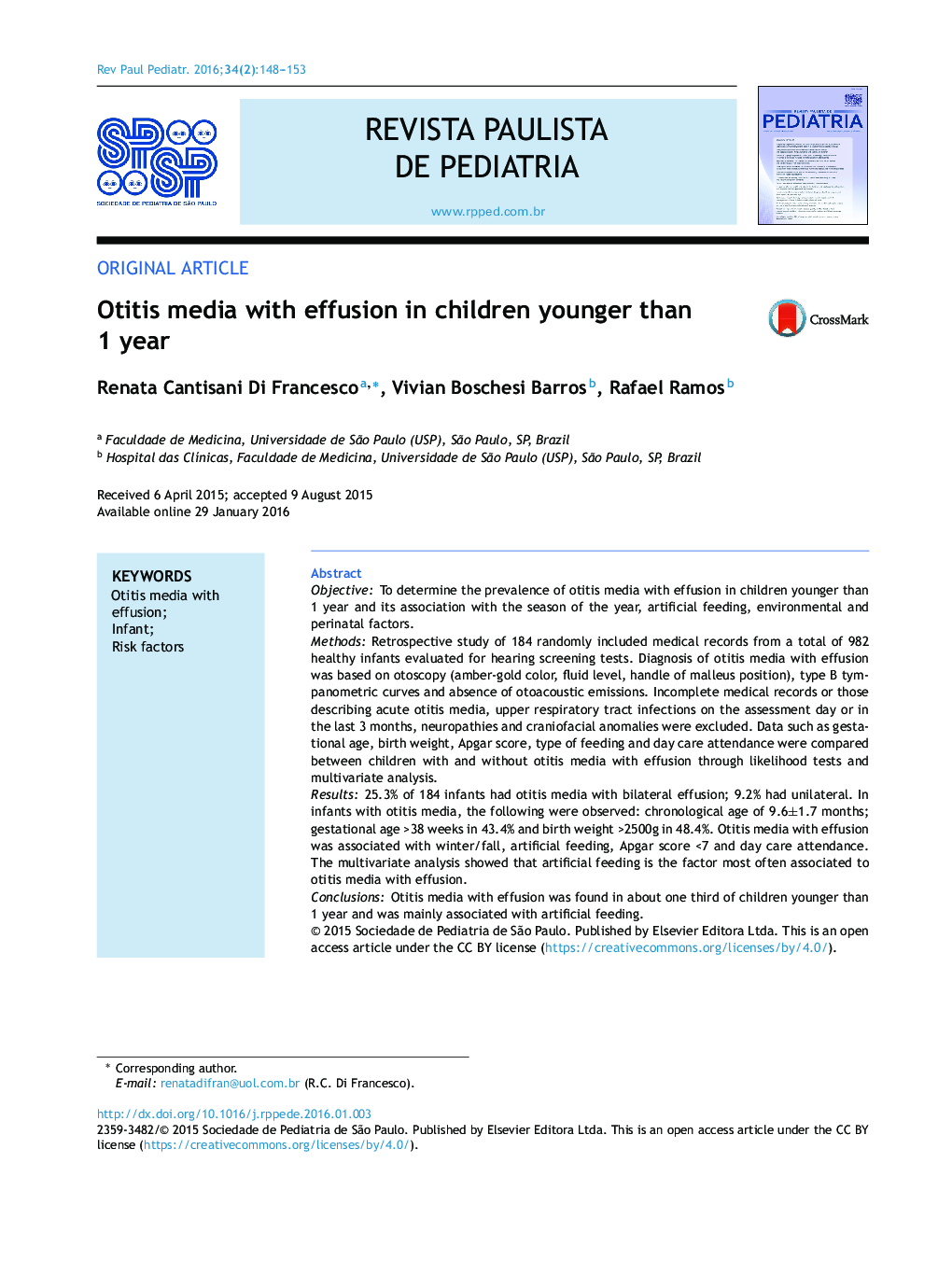| کد مقاله | کد نشریه | سال انتشار | مقاله انگلیسی | نسخه تمام متن |
|---|---|---|---|---|
| 4176148 | 1276236 | 2016 | 6 صفحه PDF | دانلود رایگان |
ObjectiveTo determine the prevalence of otitis media with effusion in children younger than 1 year and its association with the season of the year, artificial feeding, environmental and perinatal factors.MethodsRetrospective study of 184 randomly included medical records from a total of 982 healthy infants evaluated for hearing screening tests. Diagnosis of otitis media with effusion was based on otoscopy (amber-gold color, fluid level, handle of malleus position), type B tympanometric curves and absence of otoacoustic emissions. Incomplete medical records or those describing acute otitis media, upper respiratory tract infections on the assessment day or in the last 3 months, neuropathies and craniofacial anomalies were excluded. Data such as gestational age, birth weight, Apgar score, type of feeding and day care attendance were compared between children with and without otitis media with effusion through likelihood tests and multivariate analysis.Results25.3% of 184 infants had otitis media with bilateral effusion; 9.2% had unilateral. In infants with otitis media, the following were observed: chronological age of 9.6±1.7 months; gestational age >38 weeks in 43.4% and birth weight >2500g in 48.4%. Otitis media with effusion was associated with winter/fall, artificial feeding, Apgar score <7 and day care attendance. The multivariate analysis showed that artificial feeding is the factor most often associated to otitis media with effusion.ConclusionsOtitis media with effusion was found in about one third of children younger than 1 year and was mainly associated with artificial feeding.
ResumoObjetivoDeterminar prevalência de otite média com efusão em menores de um ano e sua associação com estação do ano, aleitamento artificial, fatores ambientais e perinatais.MétodosEstudo retrospectivo com 184 prontuários incluídos de forma randomizada dentre 982 lactentes saudáveis avaliados para testes de triagem auditiva. Diagnóstico de otite média com efusão baseou-se em otoscopia (coloração âmbar-ouro, nível líquido, posição do cabo do martelo), curva timpanométrica tipo B e otoemissões acústicas ausentes. Excluíram-se prontuários incompletos ou que descreviam otite média aguda, infecções de vias aéreas superiores no dia da avaliação ou nos últimos três meses, neuropatias e anomalias craniofaciais. Dados como idade gestacional, peso ao nascimento, Apgar, tipo de aleitamento, frequência à creche foram comparados entre crianças com e sem otites com efusão por meio de testes de verossimilhança e análise multivariada.Resultados25,3% dos 184 lactentes apresentavam otite média com efusão bilateral; 9,2% unilateral. Nos lactentes com otite média, observou-se idade cronológica 9,6±1,7 meses; idade gestacional >38 semanas em 43,4% e peso ao nascer >2.500g em 48,4%. Otite média com efusão foi associada ao inverno/outono, aleitamento artificial, Índice de Apgar <7 e atendimento à creche. Já a análise multivariada demonstrou que o aleitamento artificial é o fator mais associado à otite média com efusão.ConclusõesA otite média com efusão foi encontrada em cerca de 1/3 dos menores de um ano e principalmente associada ao aleitamento artificial.
Journal: Revista Paulista de Pediatria (English Edition) - Volume 34, Issue 2, June 2016, Pages 148–153
